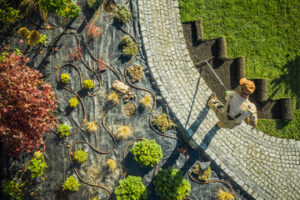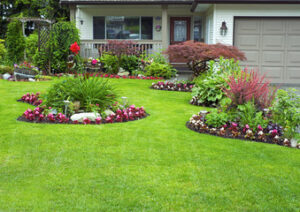Landscaping Springdale AR enhances the beauty of your home and yard. It also raises property value and makes outdoor living spaces more functional. It can include plants, trees, water features, pathways, patios and decorative stone elements.

Choose a color scheme that works for your garden. Combine flowers in warm and cool colors for contrast, or keep the same theme throughout for a unified look.
Mulching is a technique that improves soil health, conserves water and suppresses weeds. It also moderates soil temperature, prevents frost heaving and makes the garden bed look more attractive. Mulching can be done with both organic and inorganic materials. However, the type of mulch to use depends on the soil conditions and particular planting needs. Organic mulches, like shredded bark and leaves, break down to provide valuable nutrients for the soil.
Inorganic mulches, like gravel or synthetic weed barriers, do not break down and add to the soil, but they do help prevent weed growth. It is best to avoid impermeable sheeting around plants because it can block the rain, air and nutrients that are needed for proper plant growth.
There are many types of mulching available, from organic wood and bark chips to rubber mulch. Organic mulches can be made from wood, compost, hay or straw. They are a good option for flower and shrubbery beds, as they do not compact easily and do not wash away. Organic mulches are more costly than inorganic options, but they provide a great benefit to the garden and are an excellent way to improve the appearance of your landscape.
Other organic mulches include pine needles and eucalyptus leaf litter. These mulches are also renewable and sustainable. They may add some acidity to the soil, but it is not enough to affect plant growth. Rock mulches, on the other hand, will raise the soil temperature and can be damaging to roots and impede growth. They are better used in arid climates, where the sun’s heat is not as intense. In addition to providing an aesthetic benefit, mulch can also provide a habitat for native pollinators.
Pine needles
Pine needles, also known as pine straw, provide a beautiful, natural, and cohesive look to commercial landscape designs. They are an excellent choice for retaining water and preventing weeds, and they add organic matter to the soil as they decompose. However, there are several drawbacks to using this type of mulch that property managers and gardeners should consider.
The primary disadvantage of pine needles is that they tend to acidify the soil over time, which can be detrimental to some plants (such as ferns and rhododendrons) that require a more alkaline environment. Additionally, they are more flammable than other types of mulch, creating a fire hazard if left to pile up against buildings or structures in dry climates.
Another common issue is that the needles often choke out grass and flowers planted beneath a pine tree, leaving bare patches of dirt. They are also difficult to rake and take much longer to decompose than other types of leaves. For these reasons, property managers should keep an eye on the amount of pine needles in the garden and regularly remove them.
For those looking to reduce the amount of pine needles in their garden, harvesting them can be a great option. This material can be used as mulch or in a variety of other projects, including making pine needle tea and lining paths. To ensure that you are picking the right needles, identify them by their length and needle clusters; pine trees have short needles and needles that grow in groups, while spruce trees have shorter, stubby needles and develop red fruit rather than cones. If you’re unsure, you can use a phone app to help you determine the type of pine or spruce you have.
Compost
Landscaping involves combining the art of arranging plant material with the science of soil chemistry. It requires an intimate understanding of how various materials work together and a deep respect for the planet that gives us all we need to survive. It is a delicate balance between the needs of the land and the demands of our homes.
A crucial component of sustainable landscaping is making your own compost. This is a great way to reduce the amount of organic waste that goes into landfills, and it’s an easy project for any homeowner. Organic waste, such as vegetable food scraps and grass clippings, are transformed into nutrient-rich soil fertilizer in the composting process. This is a much healthier alternative to chemical fertilizers, which can damage the environment and kill healthy microbes in the soil.
Composting uses microorganisms like bacteria, fungi, and earthworms to break down organic materials like leaves, grass clippings, eggshells, tea bags, and vegetable food scraps. These organisms decompose the organic materials in aerobic conditions (meaning there is oxygen present) while generating heat, which helps break down the matter and makes it ready to use as fertilizer in garden soil.
In addition to adding valuable nutrients to the soil, compost also helps improve its aeration and water retention abilities. It is also an excellent substitute for synthetic fertilizers, which are harmful to animals and insects. Compost also attracts earthworms, which are essential for healthy soil and help aerate the soil.
If you’re new to sustainable landscaping, try starting small and choosing one corner of your yard to go organic. Using compost-rich soil, a few native plants, and mulch to keep moisture locked in and block out weeds is an affordable and effective way to test the waters of sustainability. Eventually, you’ll be able to create an entire landscape that’s as beautiful as it is eco-friendly.
Bark
Bark is the outer layer of a plant, most commonly on trees. It protects the inner phloem of the plant, which transports photosynthetic products throughout the plant. Consequently, if it is damaged or removed, the plant will die. It is also a habitat for a variety of organisms, including insects, fungi and lichens.
Many types of bark can be used as mulch. In addition to adding nutrients and moisture to the soil, it can also help prevent erosion. It can be purchased at garden centers, landscaping companies and home improvement stores. It is available in a variety of textures, colors and thicknesses. Some kinds of bark are shredded, while others are larger pieces that can be used to cover up roots and stems. Some of the most common bark is cypress, pecan, and pine.
There are many different types of bark, including cork oak (Quercus suber), eucalyptus bark, and black poplar. Bark can be found in a wide range of habitats, from deserts to swamps and forests. It is a natural resource, and it can be recycled into useful items such as flooring, furniture, and even shoes.
A lot of people have bad things to say about bark. But is it really that bad? We will take a look at the facts and find out.
Grass clippings
Grass clippings are an abundant resource that can be used in several ways to improve lawn and garden health. They contain water, cellulose, and nutrients like nitrogen, phosphorus, and potassium, making them ideal for compost piles and garden mulch. By utilizing these resources, you can reduce waste, save money on fertilizer, and create a beautiful yard. However, many homeowners don’t know how to properly use grass clippings. Many simply bag them up and put them in the trash, contributing to overflowing landfills.
Keeping grass clippings on your lawn provides valuable nutrient-rich soil, and helps the lawn retain moisture, especially during hot weather. In addition, it helps control thatch buildup and is an excellent substitute for chemical fertilizers. Using this method, known as “grass cycling,” also eliminates the need for raking or bagging, and it cuts down on waste and costs. If you choose to grass cycle, be sure to mow your lawn regularly to avoid clumping and keep the grass low enough that it can decompose quickly.
The grass clippings can be used in a layered gardening method called “lasagna” and added to the topsoil of new or existing garden beds. The layering process helps the garden bed become nutrient-rich over time, and it is particularly helpful for starting or revitalizing new gardens. To make a lasagna garden, start with a layer of corrugated cardboard on the bottom, followed by a layer of grass clippings and another layer of brown materials like leaves or kitchen scraps.
Grass clippings can also serve as bedding material in worm bins or vermiculture systems. Just be sure to let the clippings dry out a bit before adding them to your system to prevent excessive heat or mold growth.
